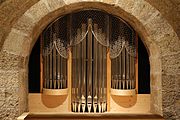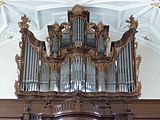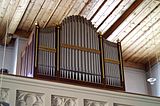Johannes Strebel
| Organ building institute Strebel | |
|---|---|
| legal form | Sole proprietorship |
| founding | 1884 |
| Seat | Nuremberg , Germany |
| management | Johannes Strebel |
| Branch | Organ building |
Johannes Strebel (born January 17, 1832 in Forchtenberg , † June 20, 1909 in Nuremberg ) was a German organ builder .
Life
Johannes Strebel was the first child of a large family of priests of Franconian origin. Johannes' father, Johann Valentin, came from Schweinfurt in Lower Franconia , but was not allowed to exercise the office of pastor there because of his membership in the Bubenreuth fraternity . Thereupon the Evangelical Church in Württemberg accepted him and gave him a pastor's position in Roßwangen in 1858 . He died on May 11, 1883. His mother, Johanna Emilia Magdalena Harleß (born 1809 in Nuremberg ), came from the Franconian family of scholars Harleß, she was the granddaughter of Gottlieb Christoph Harleß , her brothers were Adolf Harleß and Emil Harleß . Johannes' brother was the agricultural economist Ernst Valentin von Strebel .
Johannes Strebel began his career as an organ builder in 1848 with a six-year apprenticeship in the Ludwigsburg organ building workshop of Eberhard Friedrich Walcker . After two years as a journeyman there, he worked for another two years with Georg Friedrich Steinmeyer in Oettingen , who had also been trained by Walcker. He trained as a harmonium maker at Schiedmayer in Stuttgart from 1858. Then he went "on a roll " to Barmen to the piano maker Ibach and to Paris to Aristide Cavaillé-Coll . He turned down the offer to represent his company in Spain and returned to join Steinmeyer in 1864 as a partner in a management position. The company experienced a steep rise in the following twenty years. Strebel was u. a. Head of harmonium construction.
After he left Steinmeyer and had made room for a younger generation, Strebel founded his own "organ building institute" in Nuremberg in 1884 at the age of 52 . First he built organs for various village churches in Franconia and the Upper Palatinate . Around 25 instruments belong to the era of the mechanical cone chest , which was replaced by the pneumatic action as early as 1891. In 1890, Strebel had Friedrich Weigle in Echterdingen transfer the rights for the sole use of the pneumatic system in Bavaria and one of his employees was thoroughly trained in it. Standing pocket shops were later used, the inventor of which Friedrich Witzig had been employed in Strebel's company since 1895. A year later he built his first larger organ with two manuals and 32 registers for the “Heilige Dreifaltigkeit” church in Regensburg .
The company profile has not changed for years. Strebel delivered several village organs per year and occasionally larger instruments in town churches. Even with the organ for the St. Sebald Church in Nuremberg, which he installed in 1906, Strebel did not go beyond the two-manual nature. The instrument, built in 1905 for the concert hall of the Nuremberg cultural association, had three manuals with 44 registers.
With the founding of the Association of German Organ Builders in 1895, Strebel was supposed to become its first chairman, but at the age of 63 he did not accept the office. In 1908, a year before his death, he handed over the organ building business to his sons Wilhelm (1873-1939) and Hermann (1874-1946). His life's work comprised around 170 mostly smaller organs with one or two manuals. His grave was in the Johannisfriedhof in Nuremberg.
Sons
The sons Wilhelm and Herrmann continued to run the company successfully until the First World War and expanded the sales area to southern Thuringia . With the organ with three manuals and 60 registers installed in the town church of Bayreuth in 1913 , they created a renowned instrument. Other Strebel organs were in synagogues in Fürth and Nuremberg. After the First World War, the brothers gave up their independence and from 1919 worked at Steinmeyer, where their father had already worked. The last work from Strebel's workshop was the organ for the Goetheanum in Dornach, Switzerland, in 1920, but the entire building fell victim to a fire in 1923. In 1921 the Strebel brothers transferred the entire company assets to the Oettinger company. Until Wilhelm Strebel's death in 1939, Steinmeyer had the addition "Steinmeyer & Strebel" in the company name.
Works (selection)
| opus | Construction year | Location | building | image | Manuals | register | Degree of conservation | Comments sources |
|---|---|---|---|---|---|---|---|---|
| 1 | 1885 | Alfalter | Ev. Church of St. Catherine | I / P | 8th | Preserved, good condition on November 3rd, 2015 | Mechanical cone tray |
|
| 1887 | Höchstädt in the Fichtel Mountains | Protestant church | I / P | 11 | receive | Restored in 1983 by Hey Orgelbau |
||
| 12 | 1889 | Rothenburg ob der Tauber | Franciscan Church | II / P | 14th | receive | 1992 Restoration of the Sandtner organ building . | |
| 1889 | Sankt Helena, municipality of Simmelsdorf | Protestant church | I / P | 9 | receive | In the case by Elias Hößler 1726 | ||
| 1890 | Bischofsgrün | Protestant church | II / P | 18th | receive | Restored in 1988 by Hey Orgelbau |
||
| 1891 | Langenzenn -Laubendorf | Protestant church | I / P | 7th | receive | Restored in 1989 by Hey Orgelbau |
||
| 1892 | regensburg | Trinity Church | II / P | 32 | not received | Prospectus pipes received. 2020 new building Hendrik Ahrend | ||
| 1892 | Schney | St. Mary's Church | II / P | 16 | partially preserved | 1957 conversion by Otto Hoffmann | ||
| 49 | 1895 | Oberhöchstadt | Protestant church | I / P | 12 | receive | Restored in 1993 by Hey Orgelbau |
|
| 57 | 1896 | Retirement home | Village church | I / P | 9 | receive | Mechanical cone tray. | |
| 1896 | Küps -Burkersdorf | Evangelical Parish Church of St. Mary | II / P | 12 | not received | |||
| 1898 | Henfenfeld | Protestant church | II / P | 14th | receive | |||
| 1900 | Dühren | Evangelical St. Michael Church | I / P | 5 | receive | Restored in 1987 by Hey Orgelbau |
||
| 1901 | Bischwind | Protestant church | I / P | 7th | receive | Restored in 1987 by Hey Orgelbau |
||
| 1901 | Gemünda in Upper Franconia | Protestant church | II / P | 12 | receive | Restored in 1999 by Hey Orgelbau |
||
| 1902 | Pastures | St. Michael | II / P | 24 | not received | pneumatic cone tray. Current: Max Reger Memorial Organ ( Weimbs Orgelbau 2007, 53 / III / P) | ||
| 107 | 1903 | Burghaslach -Kirchrimbach | Christ Church | II / P | 14th | not received | ||
| 1903 | Schernau | Parish Church of St. Andrew | II / P | 12 | receive | with pneumatic pocket drawer | ||
| 108 | 1903 | Ottensoos | Evangelical parish church of St. Veit | II / P | 13 | receive | New organ in the case by Elias Hößler (1694) | |
| 1904 | Koenigsberg in Bavaria | Marienkirche | II / P | 13 | receive | New building in the housing of Matthias Tretzscher (1660) | ||
| 112 | 1904 | Happurg | Protestant church | II / P | 14th | receive | New organ in the case by Elias Hößler (1728) | |
| 1905 | Koenigstein (Upper Palatinate) | St. George | I / P | 10 | receive | In the atypical case by Funtsch, 1753 | ||
| 1905 | Nuremberg | Cultural association | III / P | 44 | not received | one of the few three-manual organs of Strebel |
||
| 1905 | Wirbenz | Evangelical Church of St. Johannis | II / P | 16 | receive | renovation following the church renovation is planned | ||
| 1906 | Rugendorf | Evangelical Luth. Parish Church of St. Jakob & St. Erhard |

|
II / P | 12 | receive | Restored in 2006 by Orgelbau Zeilhuber | |
| 1906 | Weißenbrunn | Trinity Church | II / P | 16 | receive | Restored in 2000 by Hey Orgelbau |
||
| 1906 | Wurzburg | Mariannhill Monastery Crypt |

|
II / P | 12 | receive | The organ was built for Schauerheim in 1906 and transferred to Würzburg in 2005/2006. New brochure (photo), the old one remained in Schauerheim. | |
| 1904/1906 | Nuremberg | St. Sebald | II / P | 10 | not received | 1904: Engelschor organ, burned in 1945. 1906 main organ |
||
| 1909 | Lehrberg | Evangelical St. Margaret Church | II / P | 11 | receive | 1972 Reconstruction and reorganization of Koch / Feuchtwangen | ||
| 1909 | Fuerth | synagogue | II / P | 12 | destroyed with the synagogue | |||
| 1911 | Lauscha | Evangelical town church | II / P | 28 | receive | Restored in 2001 by Rösel & Hercher | ||
| 1911 | Stadtsteinach | Catholic parish church of St. Michael | II / P | 26th | receive | 1960 Sound modification and conversion to electropneumatic action by Max Thierauf (Eusebius Dietmann). April 2020: Basic cleaning and mold removal → Organ from St. Michael (Stadtsteinach) | ||
| 1912 | Wernshausen | Protestant church | II / P | 15th | receive | 2010 Restoration of Hey Orgelbau | ||
| 1912 | Edelsfeld | St. Stephan | I / P | 9 | received, completely refurbished in 2019 by Kilbert | In the case by Elias Hößler , 1698 | ||
| 1912 | Kelheim | St. Matthew | II / P | 12 | receive | 1988 von Eisenbarth expanded to 13 registers | ||
| 1913 | Bayreuth | City Church | III / P | 60 | not received | Burned in 1918 |
||
| 1913 | Röthenbach on the Pegnitz | Evangelical Holy Cross Church | II / P | 32 | received, 2002 general overhaul |
|
||
| 1913 | Nuremberg | St. Paul Church | II / P | 22nd | receive | 1319 pipes. Pneumatic play and stop actions. | ||
| 1914 | Hausen | St. Peter and Paul Church | I / P | 4th | receive | with pneumatic pocket drawer | ||
| 1914 | Neunkirchen near Weiden in the Upper Palatinate | Protestant church | II / P | 11 | receive | 1964 Renovation of Dentler / Siegen | ||
| 1915 | Gattendorf | Gattendorf parish church | II / P | 9 | receive | Restored in 1999 by Hey Orgelbau |
||
| 1916 | Redwitz an der Rodach | Evangelical Parish Church of St. Aegidius | II / P | 14th | receive | The organ (?) Rebuilt by Strebel was restored in 1984 by Hey Orgelbau |
||
| 1916 | Graefenthal | Evangelical St. Mary's Church | II / P | 29 | receive | Behind a baroque prospect, rebuilt in 1945 | ||
| 1917 | Hamburg | Crypt in the Hamburg Michel | II / P | 7th | receive | Expanded super-octave coupling. Restored in 2009/2010, electric console → organ | ||
| 1920 | Dornach (Switzerland) | Goetheanum | not received | Burned in 1923 |
Web links
- Invitation to the 100th anniversary of death at Myheimat.de
- Organ database Bavaria, Version 5 (2009), ed. by Michael Bernhard
- Information and pictures about the sons Wilhelm and Herrmann Strebel from the Steinmeyer archive on Facebook
Individual evidence
- ↑ Website of the Bubenreuther ( Memento of the original from March 5, 2016 in the Internet Archive ) Info: The archive link was inserted automatically and has not yet been checked. Please check the original and archive link according to the instructions and then remove this notice.
- ↑ Funeral oration of Johanna Strebel geb. Harleß, 1882 near Dittmar / Vaihingen
- ↑ a b c d The historical Strebel organ (1913) of the parish church of St. Paul in Nuremberg
- ↑ a b c d Bavarian organ database
- ↑ a b c d e f g h i j k Website of Hey Orgelbau
- ^ Sandtner organ building - information. In: sandtner-orgelbau.de. Retrieved August 10, 2017 .
- ↑ Martina Topp: The organ in the Dreieinigkeitskirche in Regensburg. In: Roma Quanta fuit. Wißner, Augsburg 2010, ISBN 978-3-89639-799-7 . P. 655 ff.
- ↑ Kleinweisach website ( Memento of the original dated September 23, 2013 in the Internet Archive ) Info: The archive link was inserted automatically and has not yet been checked. Please check the original and archive link according to the instructions and then remove this notice.
- ↑ Information on the homepage of the company Zeilhuber ( Memento of the original of July 17, 2016 in the Internet Archive ) Info: The archive link was automatically inserted and not yet checked. Please check the original and archive link according to the instructions and then remove this notice. , accessed July 17, 2016
- ^ Mariannhill website , accessed December 31, 2016.
| personal data | |
|---|---|
| SURNAME | Strebel, Johannes |
| BRIEF DESCRIPTION | German organ builder |
| DATE OF BIRTH | January 17, 1832 |
| PLACE OF BIRTH | Forchtenberg |
| DATE OF DEATH | June 20, 1909 |
| Place of death | Nuremberg |

























